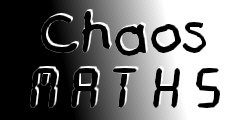| Mathematics is said to be the discipline of science, that is most predictable of all. Everything is calculatable, no result is surprising, it's logical, it's clear, everyone on the whole world will get the same result when calculating the same thing. So what is Chaos Maths? Well, a better name would be Deterministic Chaos. Calculated chaos? If you are interested follow me on a little trip into the world of math...
|
|
Simply regard the following equation: A = B * (C - C˛). Nothing hard, isn't it? Now, we will do the following, we choose a fixed B and C, let's say 2 for B and 0.1 for C. When you put in this into the equation you get:
|
|
A = 2 * (0.1 - 0.1˛)
|
|
This can be easily be solved with any calculator. I got around 0.18. Normally you would finish here, you solved the equation and everything is fine, but this time we want to do something what math-people call iteration: We take the result (0.18) and use it again in the same equation as a new C:
|
|
A = 2 * (0.18 - 0.18˛)
|
|
If you make this very often you will get a list of numbers. One for the first iteration, for the second.... Look at this graph (Vertical axis is the result, horizontale axis is number of iterations):
|
|
|
|
Very unspectacular, isn't it? The graph has only one direction. It heads for it and when I reaches it there is no further movement. Well, we gonna stick a little bit deeper: Now we take 2.7 as starting value for B (A = 2.7 * (0.1 * 0.1˛))
|
|
|
|
You see this time the graph grows very strong, jumps over a certain point, and then drops down again. After 11 or 12 iterations the movement has stopped on a fixed value. Here goes 3.1 for B...
|
|
|
|
Yeah, we allready got another sort of graph. It builds up a certain distance and then jumps up and down for infinity. Not yet any chaos.... :(. But hey, look at this what happens at around 3.55:
|
|
|
|
Now there are 4 fixed points between the graph is jumping. No chaos. If you know would make very little steps ahead you would first get 8, then 16, 32 fixed points, but then finally around 3.87 chaos rules...
|
|
|
|
This one is chaotic, there is no direction, there is no certain point the graph jumps over. Pure chaos. What does this bring about? When you read the Chaos Main Section (coming soon) you'll know, that chaos theory says that little effects may chause gigantic changes, if they occur in a chaotic system, so let's have a look: Blue graph = 3.87, Red graph 3.869:
|
|
|
|
You see 0.001 made a difference that develops greater and greater over time. You cannot predict the one graph by considering the other, you cannot even predict one graph, if you know it by 99.99999999%, so you have to admit that it's unpredictable.
|
|
That's the end of my little introduction into the deterministic chaos. I hope you learn the following things a. what deterministic chaos is, b. how easy you can produce it and c. that you should never trust in weather forecast. :)
|
|
The graphs are all made by a little Java applet. See the source or download. It uses 4 Parameters(StartValue1,StartValue2 (= Starting C), BValue1 and BValue2). Please read copyright.
|


